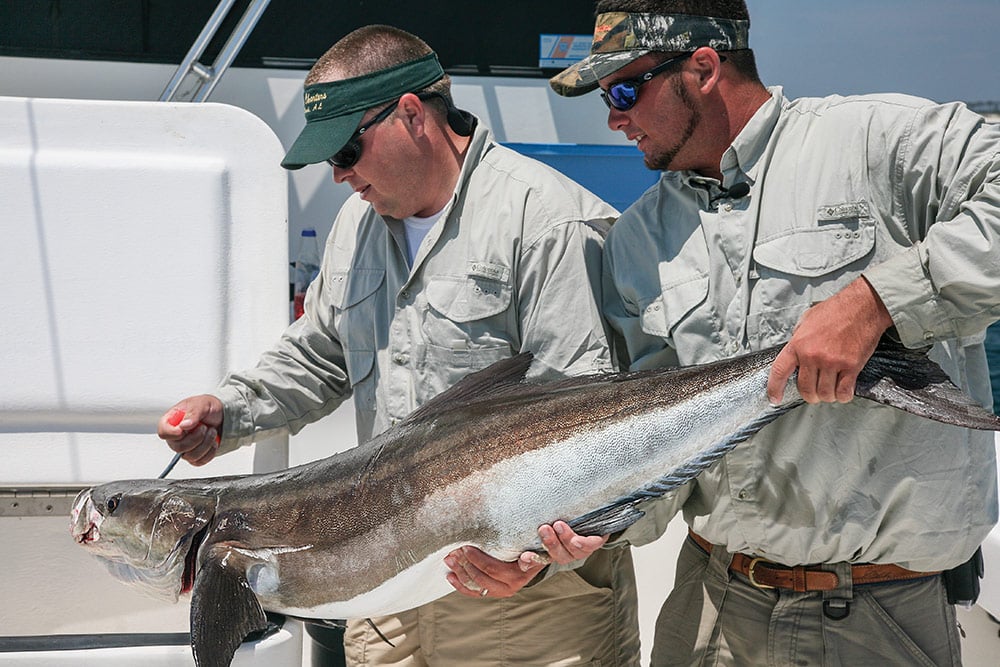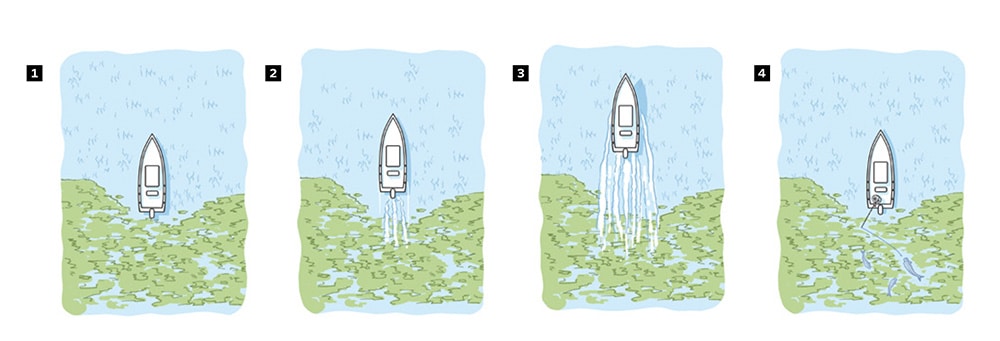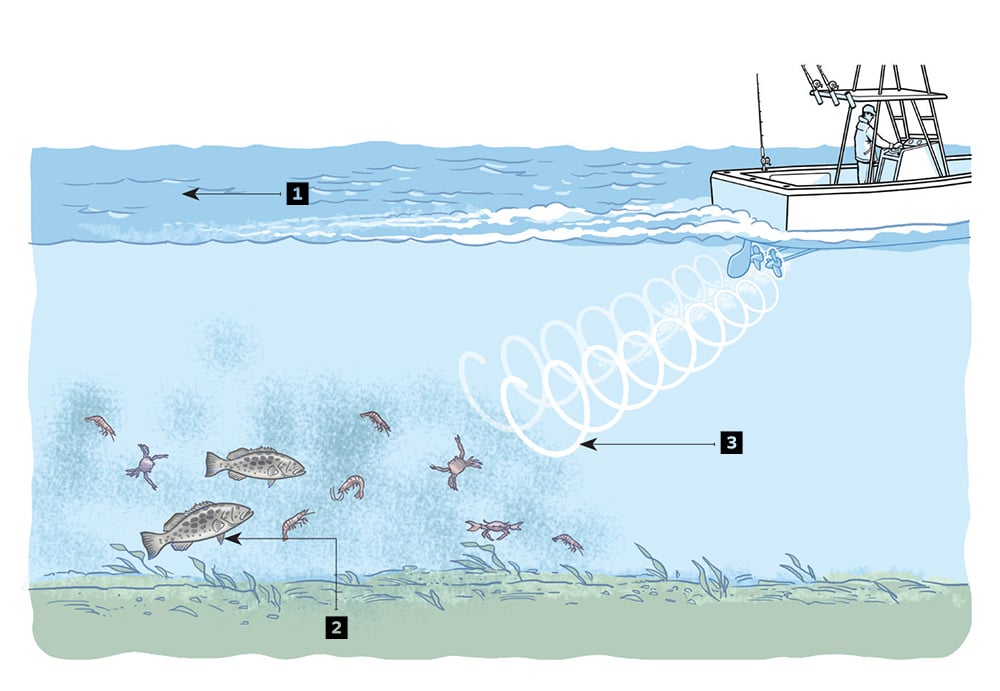
Is stealth necessary to score more fish? Quietly approaching a fishing spot is one of the first tactics we’ve learned. Th erefore, we continue to cut the motors and drift through zones, gingerly lower anchors, idle through bay and sound waters to prevent spooking fish, and speak in whispers. Yet, at times, we still score impressive catches under completely opposite scenarios.
A few years back, heading in from a successful dolphin outing, Carl Grassi and I happened upon a large ship rope and more dolphin. With plenty of fish to clean, Grassi was content to sit this one out, but I wasn’t. The ocean was flat, enabling me to stand on the bow and release a few more dolphin. I was about to swing another one aboard when a blue marlin suddenly inhaled it, less than 10 feet away (it sounded and wore through my 30-pound leader nearly immediately). What’s intriguing is that the marlin fearlessly charged right to the boat with me in plain view, the outboards running and Led Zeppelin blaring from the sound system. Despite the din, that marlin had a Whole Lotta Love for the dolphin.
Environment Dictates
The quietness of an approach hinges largely on the environment. That is, in shallow bays and on flats, fish are more vulnerable to predation, especially from above. Sound also penetrates skinny waters more thoroughly than deeper haunts. Therefore, the slightest vibration or sudden change in that limited environment sends game fish scurrying into the sanctuary of a deep channel.
Stalking permit on the flats, for example, requires the utmost stealth, whereas these same fish often seem oblivious to a boat when they’re around a Gulf or Atlantic wreck. Snook turn cautious on the flats, in tiny creeks and under small, shallow-draft bridges yet seem undaunted by boats roaring above them when they congregate in inlets and passes to spawn.
I recall an evening with snook guru David Justice, when he became insistent on our shutting down a few hundred feet shy of a spot and using only our trolling motor to approach. “We’ll have one shot at a monster snook, if we don’t spook it,” said Justice as we bucked a tough current and wind.
He ordered us to not drop anything or step loudly on deck and to keep communications short and to a whisper. Sure enough, on the second cast, he caught a 30-pound snook.
Ironically, this spot was inside Government Cut and along one of the busiest marinas in Miami. Afterward, I had to chuckle over our clandestine tactic. Sure, Justice produced, but we were in bustling Government Cut and at a busy marina. I believe these fish are conditioned to the motorized backdrop, and it wouldn’t have made a difference if we used the outboard. I’d also bet the local snook would become more suspicious if the waters suddenly fell quiet, devoid of all boat traffic and noise.

Follow the Leader
Natural Bait Dispensers
More recently, while fishing with some of our service men and women at the U.S. naval base Guantanamo, we anchored just inside the mouth of the Guantanamo River. The drill was to pitch a weighted live herring into the shipping channel for snook. When I saw the large wake and churned-up water behind an approaching ship, I knew this would be a frustrating endeavor. However, one of the troops said to cast behind the ship, once it passed. To my surprise, we caught a snook.
We repeated the tactic several times with the same surprising success. As he explained, the local snook, cubera snapper, tarpon and jack crevalle have grown accustomed to foraging on crustaceans and baitfish displaced by these ship wakes.
Similarly, it’s not unusual to troll for dolphin several hundred feet behind a freighter, where the massive disturbance often warrants an investigation from them, particularly if the ship pushes through a weed line. We’ve caught dolphin on several occasions like this.
The next time a freighter is traversing the shipping lanes, or a large ship or boat cruises through a pass or inlet and, perhaps, even under a bridge, don’t be so quick to put down the rod or move. You might forgo an excellent chance at catching quality fish.

Liven Up a Weed Line
2. Punch the throttles to drive prop wash deep beneath the weeds.
3. Continue accelerating away from the weed line to push lots of turbulence beneath the floating weeds.
4. Return to the starting point, where the disturbance has dislodged and dislocated small fish, crustaceans and other forage species, then deploy baits into the fray, where predators will be feeding on the abundance. Steve Sanford
Curiosity Kills the Fish
Making noise has its advantages. Dolphin gravitate to the sound of boats trolling and even drifting. If fish aren’t spotted along a weed line, by debris or in a fishy area, try fan-casting a chugger. Recently, this noise-inducing tactic brought in a school of dolphin for us after what had been a lifeless drift.
Swishing a rod tip in the water also attracts dolphin, as does revving outboards. On a larger scale, try backing up to the edge of a weed line, hammering the throttles forward and stopping once the boat gets on plane. The noise, immense blast of white water, and displaced weeds and bait attract dolphin, trust me.
Cobia fall for the same disturbance tactics. Hitting the hull sides with your hand and even tapping a buoy with a paddle or gaff handle arouses their curiosity. Ditto with amberjack over wrecks; revving engines, pivoting the boat in a couple of 360 patterns to churn up the water, and splashing a large hookless lure often entices them to the surface, where they’ll readily eat lures and flies.

Mix It Up
Hunger Rules
Like the blue marlin mentioned earlier, deep hunger overrules caution. Off Pompano Beach, I fished with some Coastal Conservation Association members, combining kite- and bottomfishing while drifting. A sailfish swam up alongside the boat, curious like a dolphin. One guy grabbed a bottom rod with a large heavy jig. He ignored my instructions to hold off as I was pinning a live pilchard onto a spinning outfit for him; he dangled that heavy metal in front of the sailfish. I was stunned when the sailfish ate the jig. It’s generally a good practice to be minimally obtrusive. In many cases, like on the flats, it’s religion if you want to score. However, bear in mind that in many situations, fish aren’t afraid of noise, and they’re even attracted to it on occasion.
Know the difference between the Good Times, Bad Times to be quiet. Led Zeppelin just might be the trick that stirs things up.









